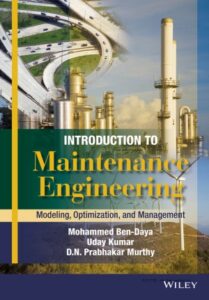Introduction to Maintenance Engineering
Introduction to Maintenance Engineering
Introduction to Maintenance Engineering. Modelling, Optimization and Management ,Modern societies use a range of engineered objects for many different purposes. The objects are designed and built for specific functions. These include a variety of products (used by households, businesses, and government in their daily operations), plants, and facilities (used by businesses to deliver goods and services) and a range of infrastructures (networks such as rail, road, water, gas, electricity; dams, buildings, etc.) to ensure the smooth functioning of a society.
The reason why engineered objects (be they products, plants, or infrastructures) need maintenance is that every object is unreliable, in the sense that it degrades with age and/or usage and ultimately fails when it is no longer capable of discharging its function.
You can also Read Case Studies in Reliability & Maintenance
Introduction to Maintenance Engineering Contents
- An Overview
![Introduction to Maintenance Engineering]()
- Basics of Reliability Theory
- System Degradation and Failure
- Maintenance – Basic Concepts
- Life Cycle of Engineered Objects
- Technologies for Maintenance
- Maintainability and Availability
- Models and the Modeling Process
- Collection and Analysis of Maintenance Data
- Modeling First Failure
- The Modeling CM and PM Actions
- Modeling Subsequent Failures
- Optimal Maintenance
- Maintenance Optimization for Non‐Repairable Items
- Maintenance Optimization for Repairable Items
- Condition‐Based Maintenance
- Maintenance Management
- Maintenance Outsourcing and Leasing
- The Maintenance Planning, Scheduling, and Control
- Maintenance Logistics
- Maintenance Economics
- Computerized Maintenance Management Systems and e‐Maintenance
- Case Studies
Maintenance actions compensate for the inherent unreliability of an object and may be grouped broadly into two categories: (i) preventive maintenance (PM) to control the degradation process and (ii) corrective maintenance (CM) to restore a failed object to the operational state.
A maintenance engineer is a professional engineer with this background, and so is different from a maintenance technician, who is skilled in carrying out specified maintenance tasks. An understanding of the basic principles of management is also an important element of modern maintenance practice.
Furthermore, maintenance engineers/managers need advanced techniques for maintenance data analysis and also need to build models to assist in effective maintenance decision making.


Comments are closed.